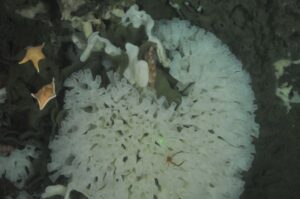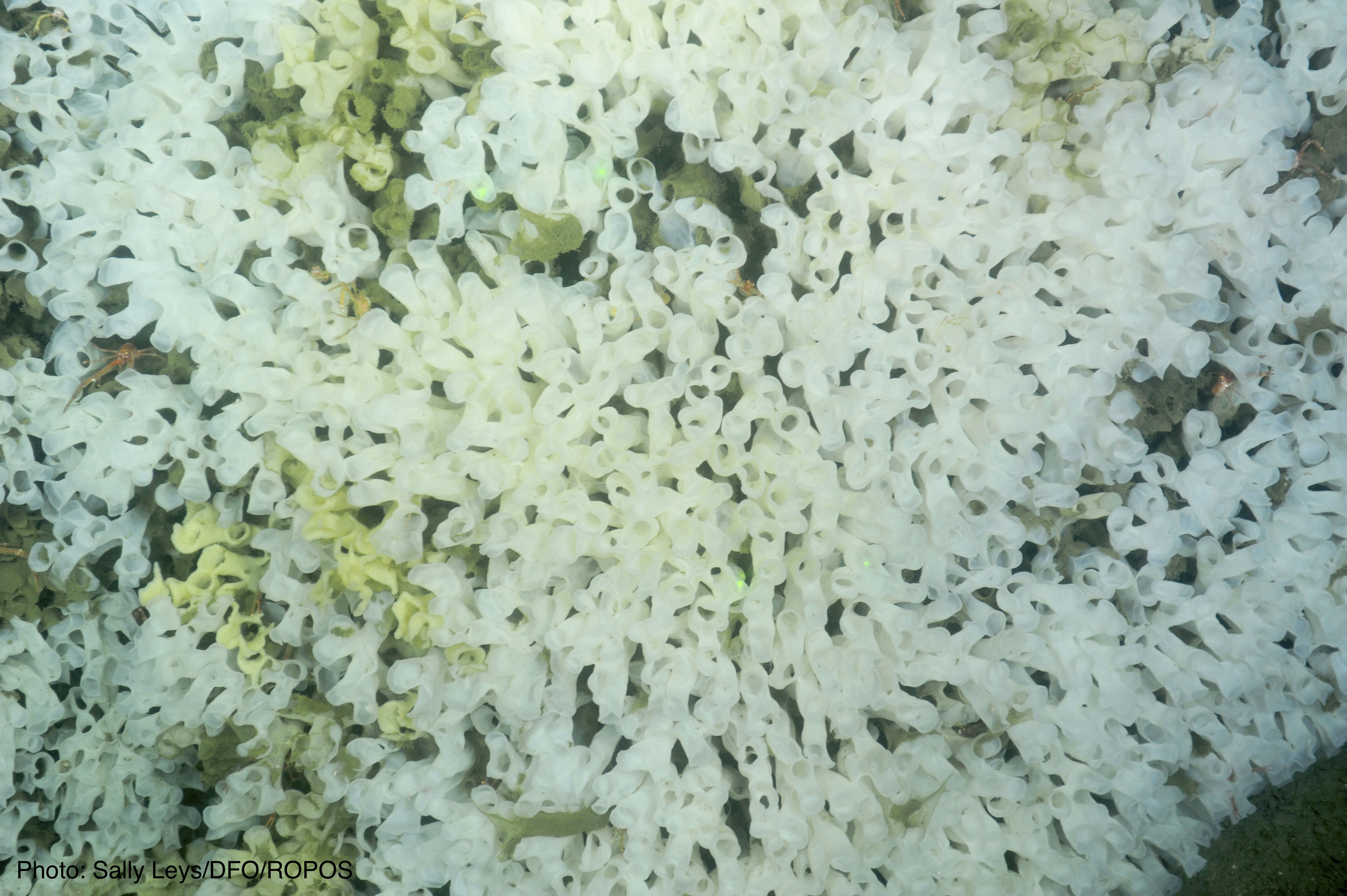Animal, vegetable or mineral?
Glass sponges do not have eyes or a mouth or stomach, and so might be mistaken for a plant or a rock, but they are in fact living, breathing animals. Adult glass sponges are “sessile”, meaning they do not move. Their bodies have thousands of tiny holes, or pores, through which water constantly flows. They absorb all the food, oxygen, and silica they need straight from the water that surrounds them. They get rid of their waste straight back into the water, which they pump out through their tube-shaped “oscula” with the help of the surrounding water current.
To reproduce, glass sponges release their ‘babies’ into the water as tiny swimming larvae that are carried by currents. If they land on a suitable surface, for example another glass sponge or a rock, they will transform and grow into a small replica of the adult. 1,2

Left: Heterochone calyx growing on a pebble, Middle: Farrea occa and Aphrocallistes vastus settled on one another, Right: Glass spicules of Farrea occa (credit: Dr. Manfred Krautter)
Glass sponges form a massive skeleton for structural support. The skeleton is made of silica, which the sponge forms into delicate needle-like structures called “spicules”. Cleverly, glass sponges also fuse the points on the spicules together, much like scaffolding, to create a lattice-like skeleton. Their intricate skeleton is further strengthened as they grow and touch other glass sponges gaining support from each other and creating the three- dimensional framework, which is called a reef. 3 These skeletons remain intact long after the sponge itself dies, which has resulted in some reefs reaching heights of up to 20 m 4 – the height of a six-storey building.
The three species of glass sponges in Hecate Strait that are able to build reefs require an amazing amount of silica. If the reefs grow only one centimetre per year, it has been estimated by scientists that it would take 57,000 5,6 tonnes of silica. This is the equivalent of 1,000 railway cars full of silica a year!
Glass kingdom on the seafloor

Sea stars, rockfish, and squat lobsters find refuge in and amongst the sponges. Photo: Sally Leys / DFO / ROPOS
According to glass sponge expert Dr Sally Leys, the glass sponge reefs form an “oasis of life” in the middle of the barren and flat seafloor. On the bare mud a small shrimp or a young rockfish has nowhere to hide from predators. The glass sponge reefs provide much needed shelter and act as a nursery for many small fish and invertebrates, such as baby rockfish or spot prawns. They can be found hiding in the chimney-shaped oscula of a finger goblet sponge, tucking themselves away in the numerous maze-like folds of Farrea occa, or hiding among the branches of a cloud sponge. 7,8
Because they span hundreds of kilometers in the Hecate Strait the reefs are able to support entire communities of other species and are particularly important for BC’s much loved spot prawns, herring, and rockfish. The reefs have been shown to have ten times more juvenile rockfish than surrounding areas. 9 This is especially important because many species of rockfish are considered threatened or endangered, yet rockfish remain an important fishery in BC. Without the reefs, could these otherwise muddy-bottomed areas support such a diverse array of species, or would spot prawns which so abundant there, be at risk?
Filter Feeders
The sponges are incredibly efficient filter feeders. One small reef only a kilometre in length in the Strait of Georgia can filter 80,000 litres a second 10 – the equivalent of an Olympic sized swimming pool in less than a minute. The sponges remove up to 90% of the bacteria, their main food, from that water. 11
Video footage courtesy: Sally Leys / DFO / ROPOS
Water enters the pores on the surface of the sponge and then travels through long, canals, and finally into small chambers. These chambers contain flagella, or little “whipping tails” that create a current that draws the water through a minute mucous mesh. As the water slows down to enter this smallest of passages, small bacteria and minute plankton are captured by the sponge and digested. The mostly carbon- (poop) and ammonia-based (pee) waste then travels out in the same water current to the osculum where it is “exhaled”. 12
Because the sponges are such prolific feeders, they are also able to process vast amounts of carbon, which in addition to their ability to filter water so efficiently, helps to move nutrients from the top of the water column all the way down to the depths. They are able to take bacteria and turn it into usable forms of nitrogen that in turn, may help boost the primary production of their surroundings by essentially fertilizing the water. 12
Glass sponges will stop pumping if sediment is stirred up into the water they filter. As sponges do not have a brain or a nervous system it is surprising that they are able to react to changes in their environment like this. Scientists have found that they can do this by sending electrical signals through their tissues. 13,14

